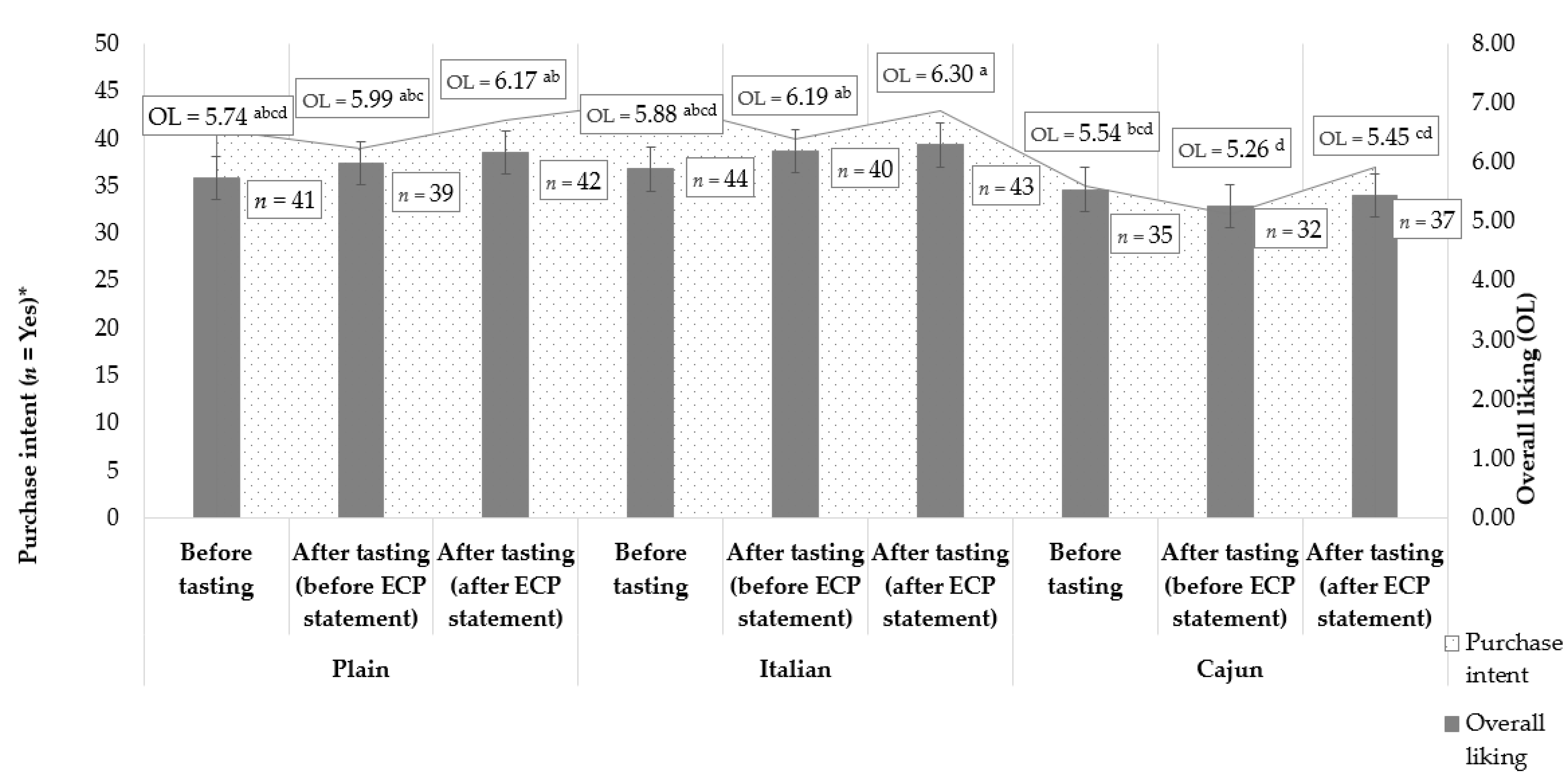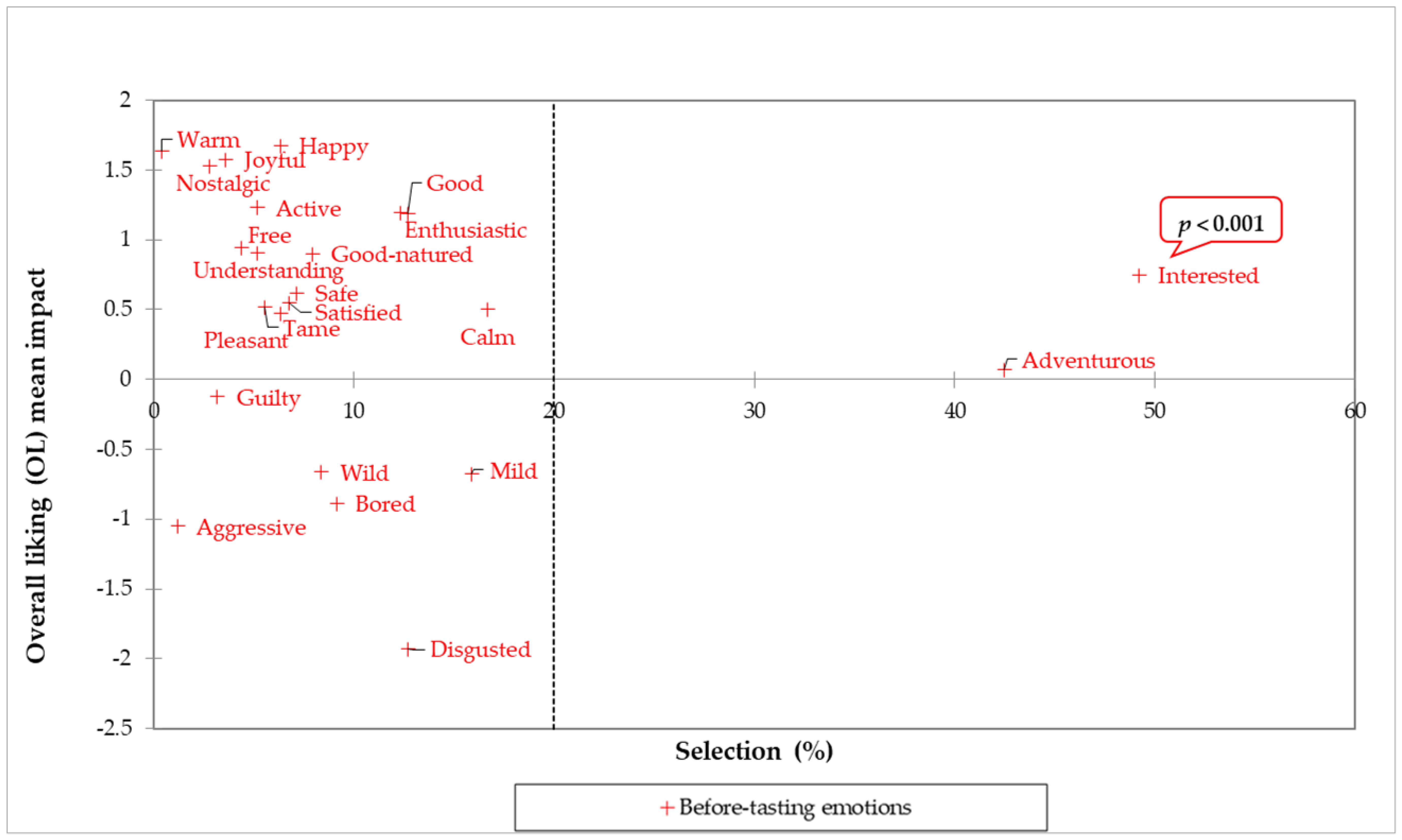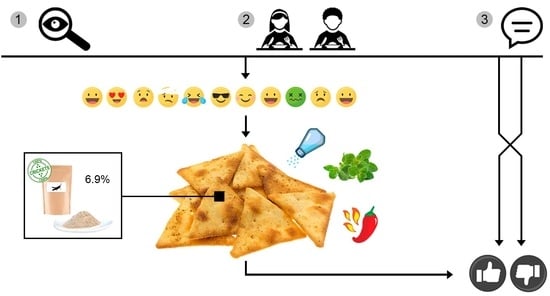3.4.1. Emotional Profiles across Moments
Figure 4 depicts the symmetric plot of elicited emotions and moments (before tasting, after tasting before ECP statement, and after tasting after ECP statement) for the plain treatment. Tasting had a more pronounced effect than the ECP statement in discriminating the evoked emotions for the plain formulation. For the before-tasting moment, the “worried” (extreme activation/arousal) and “interested” (moderate activation/arousal) emotions were associated with the plain treatment. Possibly subjects’ worry arose from a safety (health-related context) concern because of the limited information regarding edible insects’ regulations and processes that guarantee their safe use as ingredients for human foods [
8,
51,
52,
53,
54]. Yet, their curiosity and interest may have been triggered by the fact that the treatments contained ECP and the tasting experience they were about to have [
24,
55,
56].
Both after-tasting moments (before and after the ECP statement) were associated with positive-valence emotions such as “good” and “pleasant” (before the ECP statement) and “happy” and “good-natured” (after the ECP statement). However, the “disgusted” term was also highly associated with the after-tasting before ECP statement moment while the “active” high activation/arousal term was more associated with the after-tasting after ECP statement moment for the plain treatment (
Figure 4).
Ultimate product acceptability is positively associated with positive-valence emotions [
26,
27,
49] and negatively associated with “disgust” feeling, which can vary across genders [
57]. For novel products formulated with edible insects, sensation-seeking emotions, such as “active” should be elicited as they are important predictors of product acceptability [
24,
58], and previous research has emphasized that the context for launching products formulated with ECP should encompass novelty, adventure, and wild features [
8,
43].
On the other hand, the “safe” (positive valence and low activation/arousal) and “bored” (low activation/arousal) were closely positioned to both after tasting moments (before and after the ECP statement). The pattern of emotions occurrence belonging to both positive and negative valences in the pleasantness dimension and both high and low activation/arousal dimension suggests that consumers belonged to different segments [
59]. However, the pattern of emotions should be interpreted with caution as not all terms occurrences may be significant.
Table 4 shows the frequency distribution for the plain treatment emotions. Both valence and activation/arousal emotions equally contributed to the differentiation across moments, having only six (“adventurous,” “aggressive,” “good,” “interested,” “satisfied,” and “understanding”) significant emotions. The “adventurous” term frequency decreased upon tasting, but, after showing the ECP statement, it increased to a similar level than before tasting [
60]. Although the “aggressive” emotion was more elicited (
p < 0.05) after tasting (before the ECP statement) than before tasting, the compared frequencies are sparse and may not indicate any practical differences. On the other hand, the ECP statement was not effective in achieving the initial interest level for the plain treatment, which decreased upon tasting. This could reflect a partial (if not total) disagreement with the ECP statement [
61]. Regarding emotions lying in the pleasantness dimension, “satisfied” and “understanding” were more elicited (
p < 0.05) after tasting before the ECP statement and after tasting after the ECP statement, respectively, than before tasting [
62]. However, for the “good” emotion term, tasting significantly increased its frequency of occurrence, but disclosing the ECP statement after tasting caused a slight reduction in its frequency.
Figure 5 depicts the symmetric plot of elicited emotions and moments (before tasting, after tasting before ECP statement, and after tasting after ECP statement) for the Italian treatment. Again, the effect of tasting was larger than that of the ECP statement. For the before tasting moment, the “worried” (extreme activation/arousal), “mild,” “calm,” and “bored” (low to moderate activation/arousal), “free,” and “nostalgic” [
63] (positive) emotions were associated with the Italian treatment. While the worry and concern about the safety of ECP are very likely to negatively affect product liking and consumption [
64], the Italian formulation may benefit from the low to moderate activation/arousal elicited emotions as they have been found to increase appetite and food intake [
65]. The other positive emotions have an overall positive effect on product liking and consumption that has been well documented, although some studies report a weak contribution of the “nostalgic” emotion [
27,
42].
For both after-tasting moments (before and after the ECP statement), an association with positive-valence emotions such as “good” and “happy” but also with the negative “disgusted” term was observed for the Italian treatment (
Figure 5), suggesting that elicited emotions for this treatment varied across subjects, possibly because there were consumers from different segments [
59]. On the other hand, the Italian formulation was strongly associated with the sensation-seeking emotions “wild,” “aggressive,” and “active” with regard to both dimensions (F1 and F2). This reflects a positive effect of tasting for the Italian treatment as these emotions lie on the high activation/arousal dimension, which, together with liking and emotions that belong to the pleasantness dimension, have strong predictive power for consumer behavior and positively affect product consumption willingness [
8,
9,
24,
58].
Table 5 contains the frequency of the emotional responses for the Italian treatment. Only positive-valence emotions (“good-natured,” “pleasant,” “satisfied,” and “understanding”) were significant in discriminating across moments. Overall, tasting and the ECP statement had a positive effect on the Italian treatment as positive-valence terms were more evoked (
p < 0.05) upon tasting than before tasting (“pleasant” and “satisfied”) [
62] or upon disclosing the ECP statement (“good-natured” and “understanding”) [
8].
Figure 6 contains the symmetric plot of evoked emotions and moments (before tasting, after tasting before ECP statement, and after tasting after ECP statement) for the Cajun treatment. Like the other treatments, the tasting effect was larger than the ECP statement effect in the emotional profile across moments. For the before-tasting moment, the Cajun treatment was mainly associated with the “nostalgic” term, which has been categorized as a driver of sensory pleasure [
63] but also as a neutral term [
42], and to a lesser extent with the “adventurous” term, indicative of an active and energetic state [
8,
64].
Regarding Cajun treatment’s after-tasting moments, the before ECP statement was highly associated with both high and low to moderate activation/arousal emotions (“wild” and “bored”, respectively) [
66] and with the positive-valence “pleasant” term and, to a lower extent, with the negative “disgusted” term (
Figure 6). As previously mentioned, this could reflect the need for further consumer segmentation [
59], but it could also indicate mixed feelings (consumer ambivalence) [
67] toward the entomophagy concept, which is still an unfamiliar practice for Western cultures [
68]. Except for “disgusted”, the close association with the other terms may be beneficial for the Cajun treatment as evoking sensations and feelings that belong to the activation/arousal and pleasantness dimensions is a positive effect for novel foods and ingredients such as ECP [
8], and “bored” does not necessarily negatively impact food consumption [
65]. On the other hand, when the ECP statement was disclosed, the “active” and “enthusiastic” emotions belonging to the high activation/arousal dimension characteristic of the sensation seekers [
69] were highly associated with the Cajun formulation as was the positive-valence “happy” emotion. This suggests that the ECP statement had a positive effect maintaining the sensation-seeking and pleasant emotions while distancing from the “disgusted” negative emotion. Disgust feeling is among the top constraints to entomophagy in Western cultures [
24,
70]; therefore, it is a key sensation yet to be further investigated to find ways to minimize or prevent it from being elicited in foods formulated with edible insect ingredients [
71,
72]. However, the significance of each term frequency will determine their ultimate effect in discriminating among the treatments, moments, and their impact on product liking.
Table 6 presents the frequency of emotions for the Cajun treatment exploring the effects of tasting and ECP statement. As for the other treatments, emotions distribution significantly (
p < 0.05) varied across moments, but, for this formulation, mostly activation/arousal terms discriminated across moments. The frequency of the “adventurous” emotion decreased (
p < 0.05) upon tasting compared to before tasting regardless of the ECP statement, but, for the “aggressive” term, it was increased upon tasting regardless of the ECP statement. The “adventurous” emotion is characteristic of the sensation seekers [
69] market niche and belongs to the activation/arousal dimension [
73,
74], which has been suggested as the appropriate context for the introduction of ECP [
8]. Yet, the “aggressive” term has been classified as an arousal [
64], neutral [
42], and as a negative [
73] term. Hence, this effect needs to be further investigated for its relationship with product liking and the willingness to consume or to purchase the product. A positive effect of the ECP statement was observed for the “interested” and “worried” emotions. The first became less evoked (
p < 0.05) upon tasting than before tasting but increased to a similar level than before tasting after disclosing the ECP statement. The second became less frequent (
p < 0.05) when the ECP statement was disclosed when compared to the before-tasting moment. Finally, tasting increased the “warm” emotion frequency, which remained constant after disclosing the ECP statement.
However, this may represent the “warm” taste sensation imparted from the spiciness of the Cajun formulation rather than a “warm” feeling elicited by this treatment.
3.4.2. Emotional Profiles across Formulations
For the before-tasting moment, the overall hypothesis testing whether the distribution of emotions differed across formulations could not be rejected at the
p = 0.05 confidence level. However, the Italian formulation presented a significantly lower frequency of the “adventurous” emotion than the other two formulations. “Adventurous” term is an important emotional attribute ideally evoked before and after tasting because it belongs to the sensation-seeking emotions, which have strong predictive power and are drivers of liking for novelty products formulated with ECP [
24,
43,
64].
For both after-tasting moments (before and after the ECP statement), the distribution of emotions varied (
p < 0.05) across formulations. For the after-tasting (before ECP statement) moment, the “enthusiastic” term belonging to the pleasantness and activation/arousal dimensions was significantly (
p < 0.05) lower for the plain treatment when compared to the Cajun treatment while the “satisfied” positive-valence emotion was significantly lower for the Cajun treatment when compared to the Italian treatment. Possibly the variety of flavors and hot/spicy sensations from the Cajun formulation contrasted with the plain formulation flavor, making the subjects feel more “enthusiastic” about the Cajun flavor notes [
74]. The observed decreased frequency in the “satisfied” term for the Cajun treatment suggests that this emotion is an important driver of product liking, possibly leading to the observed lower OL for the Cajun formulation in the after-tasting (before ECP) moment [
8]. In addition, the “warm” emotion was significantly (
p < 0.05) more elicited for the Cajun treatment when compared to the plain and Italian formulations in both after-tasting moments (before and after the ECP statement) but, as previously mentioned, this could reflect the “warm” sensations imparted from the spicy flavor notes in the Cajun formulation. On the other hand, for the after-tasting (after ECP statement) moment, the plain and Italian formulations had lower (
p < 0.05) frequencies of the “aggressive”, “enthusiastic” (active and pleasant) [
75], and “warm” (pleasant) [
42] terms than the Cajun formulation. However, as previously mentioned, the “aggressive” term does not have a definite valence, its impact on product liking varies greatly across studies, and the “warm” term may just reflect the spiciness perception for the Cajun formulation. Hence, the observed differences in the “enthusiastic” emotion frequency across formulations may be attributed to a more varied flavor profile imparted by the Cajun treatment when compared to the plain and Italian treatments.



















